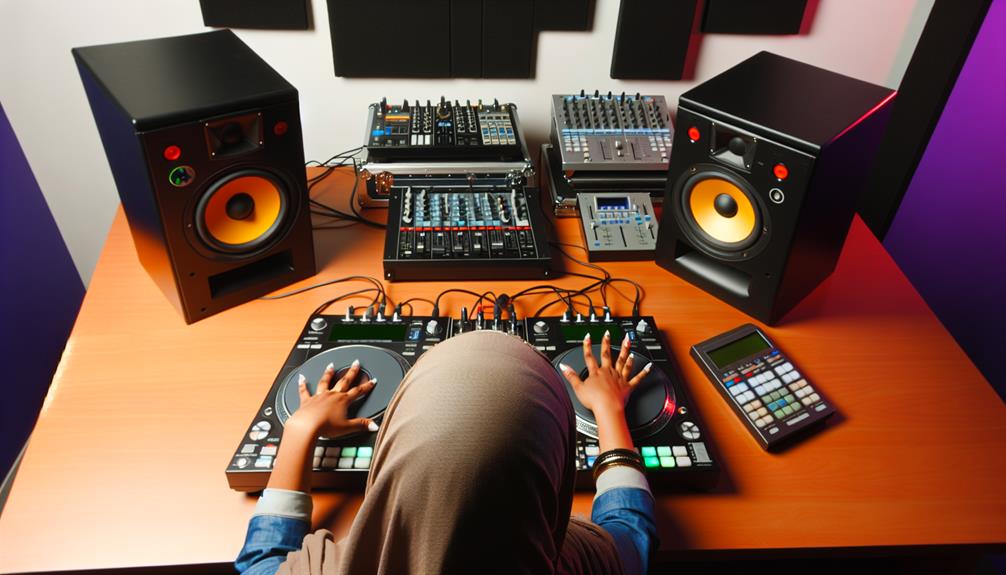Welcome to MusicMakingBasics.com
What if there’s more to creating music than just a few steps? There’s an entire world of techniques and tips waiting to be explored, offering even greater opportunities for musical expression.
When you’re starting to make music, selecting the right instrument that aligns with your preferences and budget is essential.
Then, immerse yourself in music theory to build a solid foundation. Establish consistent practice routines to make sure steady progress, and gradually face performance anxiety by playing in front of audiences. Recording your sessions can also provide valuable insights into your development.
Learning How to Make Music
Starting on your musical journey begins with selecting an instrument that truly resonates with you. Consider factors such as ease of learning, your budget, and the type of music group you’d like to join. If you’re more interested in music production, start by learning how to make beats.
Once you’ve made your choice, immerse yourself in music theory to understand the building blocks of music. This foundational knowledge will enhance your ability to read music, compose your own pieces, and even improvise.
Next, develop effective practice techniques. Consistency is key; set aside dedicated time for practice each day. Break down complex pieces into manageable sections and focus on perfecting each one. Use a metronome to improve timing and rhythm, and don’t hesitate to record your sessions to track your progress.
Performance anxiety can be a hurdle, but it’s manageable. Start by playing in front of a mirror or for a small, trusted audience. Gradually increase your audience size to build confidence. Remember, every musician experiences this, and overcoming it’s part of the journey.

Different Resources for Music Makers
There are many resources available to assist you in creating music, whether you’re a novice or an experienced musician. One of the most valuable tools is collaborative platforms like Soundtrap, which offers real-time collaboration through video and chat, enabling you to work with other musicians no matter where they’re located.
When it comes to perfecting your sound, mastering various mixing techniques is essential. Soundtrap’s auto-mixing features, EQs, and compressors cater to both beginners and seasoned users, ensuring that your tracks sound refined. Furthermore, vocal editing tools and automation options enable you to enhance and fine-tune your vocal performances effortlessly.
For those seeking to broaden their knowledge, production tutorials are an indispensable resource. Soundtrap provides detailed guides on everything from creating your first song to producing professional beats and remixing tracks. These tutorials can help you navigate the intricacies of music production with ease.
Lastly, songwriting tips can ignite your creativity and enhance your compositions. Whether you’re struggling with lyrics or melody, these tips can offer fresh perspectives and techniques to elevate your songwriting skills. Utilizing these resources will certainly enrich your music-making journey and assist you in achieving high-quality results.
Steps to Mastering Music
Mastering music involves refining and polishing your tracks to guarantee peak sound quality for distribution and playback. Start by focusing on mastering techniques like adjusting EQ, compression, and limiting. EQ allows you to balance frequencies, making sure each element in your track is clear and distinct. Compression helps control dynamics, making softer parts louder and louder parts softer, which is vital for sound optimization.
Next, use limiting to maximize the track’s loudness without causing distortion. This step secures volume consistency across different playback systems. Stereo enhancement can also be applied to widen the stereo field, giving your mix a more immersive and professional finish.
Employ specialized mastering software and tools for precise audio processing. Programs like iZotope Ozone or Waves Mastering Suite offer a range of features tailored for mastering, helping you achieve industry-standard results.
Throughout the process, constantly A/B test your master against reference tracks to make sure you’re on the right path. Pay attention to tonal balance and overall loudness to maintain a cohesive sound.

